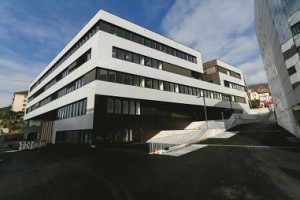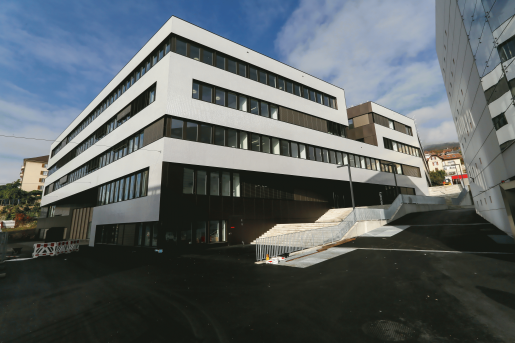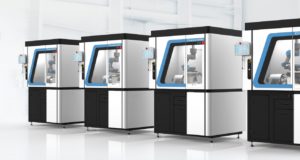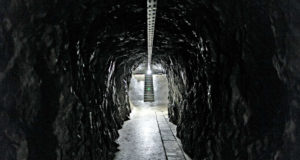
Officials hope the CHF71-million centre will become a focal point for microengineering expertise in Switzerland (rts.ch)
In the heartland of the Swiss watch industry, Neuchâtel’s new research centre, Microcity, has grand ambitions to become a global hub for microengineering that would “transform” watch technology. But weaknesses in the local economy could hold it back.
Sitting discreetly in the centre of one of Microcity’s new laboratories, a small metallic cube turns quietly on a table wired to power sources and sensors.
This prototype may not seem very special, but Professor Simon Henein and his Instant-Lab team have high hopes it could revolutionise the efficiency and precision of mechanical watches, which they say have remained conceptually unchanged since the end of the 18th century.
“This is not an incremental improvement. What we are proposing could be a breakthrough in mechanical watchmaking,” said Henein, who holds the Patek Philippe Chair in Micromechanical and Horological Design, the fruit of a 2012 partnership between the high-end watch manufacturer and Lausanne’s Federal Institute of Technology (EPFL).
Inside the metallic device, dubbed “IsoSpring”, an oscillator turns continuously in the same direction. The novelty is that it works without the use of an escapement, the most complicated and delicate watch mechanism – the source of the ticking action.
Its creators say the new device has the potential to be a very accurate timekeeper.
“The traditional tick-tock escapement mechanism makes a lot of wasteful noise and has an efficiency of only 35%. This is just a prototype but it loses only one second a day without any optimisation or oil, so it is already more accurate than some expensive pendulum clocks,” said senior scientist Ilan Vardi.
After patenting and validating the concept, Henein and his team now plan to approach industrial partners to continue its development. The next step will be to miniaturise it to fit into a wristwatch.
Patek Philippe is not the only watchmaker interested in the work at Microcity, a state-funded facility officially inaugurated on May 8. In April, EPFL and luxury group Richemont, which makes high-end watches like Cartier, Jaeger-LeCoultre and Piaget, announced the creation of an academic chair in “Multi-scale Manufacturing Technologies”.
While traditional machining and metal stamping processes still play an important role in watch manufacturing, firms are increasing looking to emerging technologies like laser machining, 3D printing and plasma etching.
“We are faced with a demanding and sophisticated client base, increasing competition and continuous technological progress,” explained Richemont Co-Chief Executive Officer Richard Lepeu. “These new technologies open a wide range of technical possibilities to respond to future industrial requirements.”
The PX Group, a leading Swiss watch accessory manufacturer, is also funding a chair in Thermomechanical Metallurgy worth CHF500,000 ($556,000) a year. Their director explains in this video why they are taking a big risk investing in the new centre.
Microcity researchers claim that their work is not unique to their sponsors and they have total scientific independence.
Reverse slowdown
From its 16th-century origins in Geneva and the Jura region, the Swiss watch industry has extended into cantons Neuchâtel, Bern, Solothurn and further afield to Basel, which hosts the annual Baselworld watch fair. In September 2013 over 57,000 people were working in the watch and microengineering sectors in 572 firms, of whom almost 15,500 were based in canton Neuchâtel.
Watch officials are hopeful that the synergies from having Microcity next to the Swiss Centre for Electronics and Microtechnology in Neuchâtel, bringing together 600 researchers, will help boost the Swiss economy and watchmaking sector, which is looking to overcome a recent slowdown in sales caused by lower demand especially in China.
Swiss watch exports, the best indicator of the size of the market, rose 1.9% to CHF21.8 billion ($24.3 billion) last year, markedly less than the rampant double-digit increases of past years.
“Microcity is at the very centre of the cluster. It will therefore attract skills, research projects and stimulate competition in a profitable way for the entire watch sector,” declared Jean-Daniel Pasche, president of the Federation of the Swiss Watch Industry.
“We need to continually innovate, especially in the field of microtechnology which is the foundation of our sector.”
Cantonal weaknesses
Viewed from outside Switzerland, the initiative also has its supporters.
“Microcity will most likely give the Neuchâtel region and Switzerland further impetus to grow and affirm their leading position in the area of microengineering not only in Europe, but worldwide,” said Iris Lehmann, an economic research manager at IVAM, an international association of companies and institutes in the field of microtechnology and nanotechnology based in Germany.
“IVAM has been watching the development of micro and nanotechnology clusters throughout Europe for a while. The Neuchâtel region is one of the hot spots of microtechnology in Europe and an outstanding example of how traditional industries like watchmaking and precision engineering can advance into highly innovative high-technologies.”
But not everyone is convinced. Elias Hafner, an analyst with UBS, said on paper the project seemed to “fit the local economy” and had the potential to develop further, giving a positive impulse to Neuchâtel’s competitiveness.
“But it is still very small by European comparison or even within Switzerland,” he added. On the French side of the nearby Jura mountains, microengineering is an important sector. In Germany too. In Switzerland, Microcity will be up against Zurich which is also a centre for microengineering and nanotechnology, in particular at the Federal Institute of Technology (ETHZ) and at the Swiss Federal Laboratories for Materials Science and Technology (Empa).
Innovative but lacks diversity
Neuchâtel was ranked 20th out of 26 cantons in UBS’s 2014 competitiveness indicator. It came fourth for innovation and second for dynamism, but did badly in terms of diversification and the labour market.
“The risk is that the canton is spending too many resources and too much hope on such a project and might not sufficiently address other important issues,” he warned. “Externally the canton is strong with high exports, good firms, and the ability to innovate – as measured for example by a high output of patents. But internally I see the weaknesses, and substance is leaving the canton.”
“Youth unemployment is the highest in Switzerland and there is an emigration of high income people from Neuchâtel to other cantons. Also, there is a relatively high public debt and an underfunded public pension which clearly limits the future financial leeway to strengthen the attractiveness of the canton.”
“These issues should be addressed more consequently.”
by Simon Bradley
Source: swissinfo.ch







